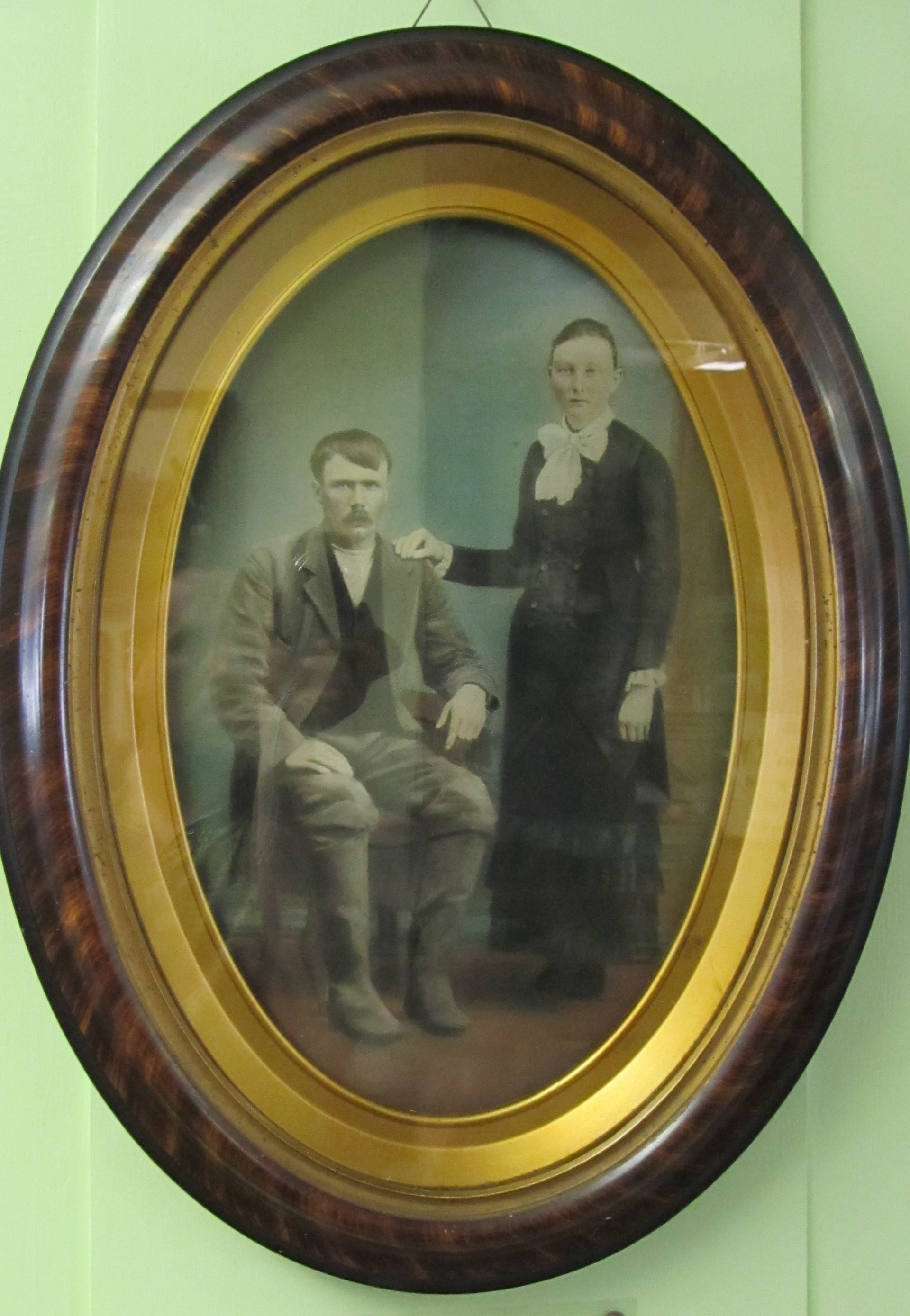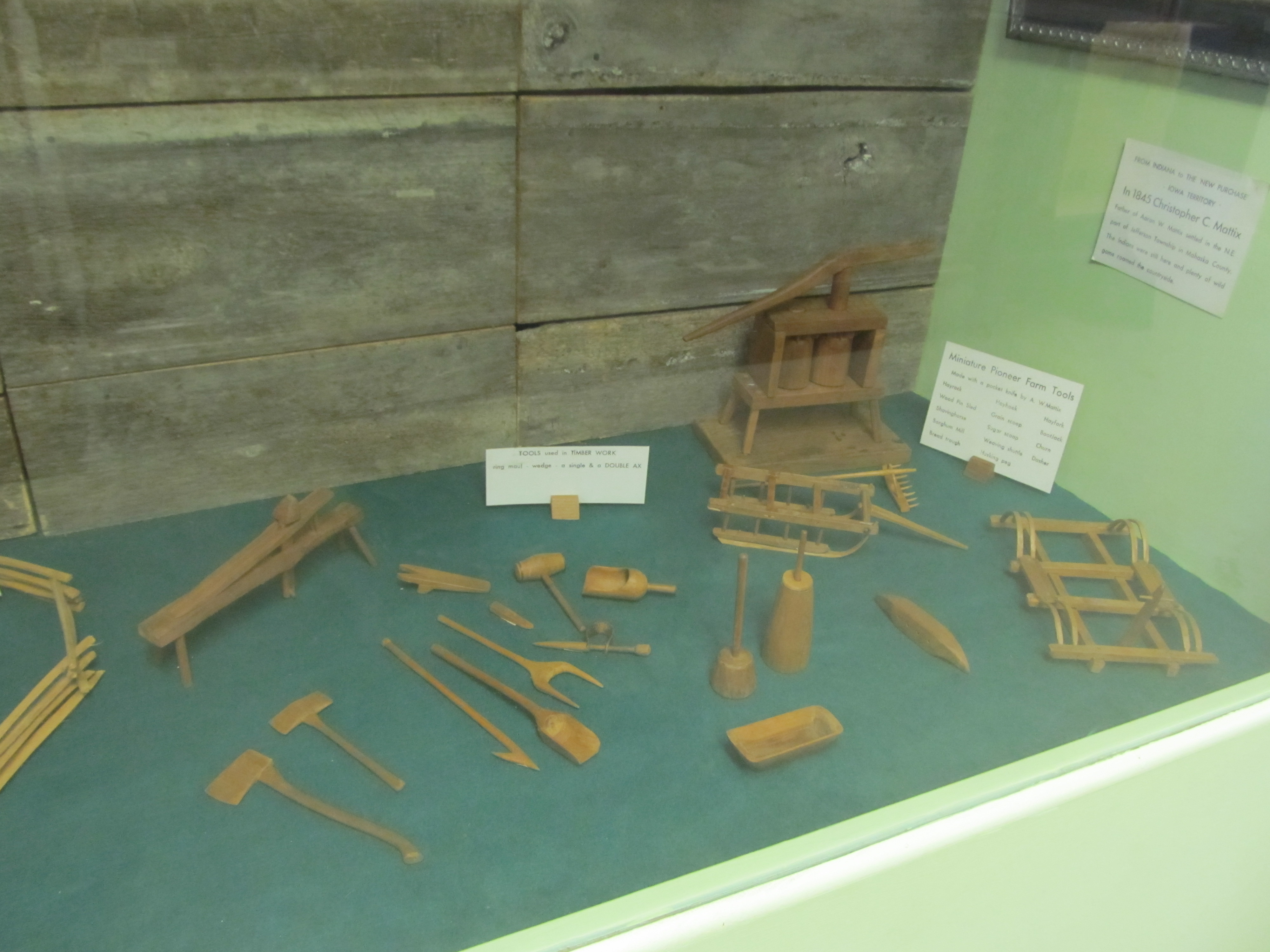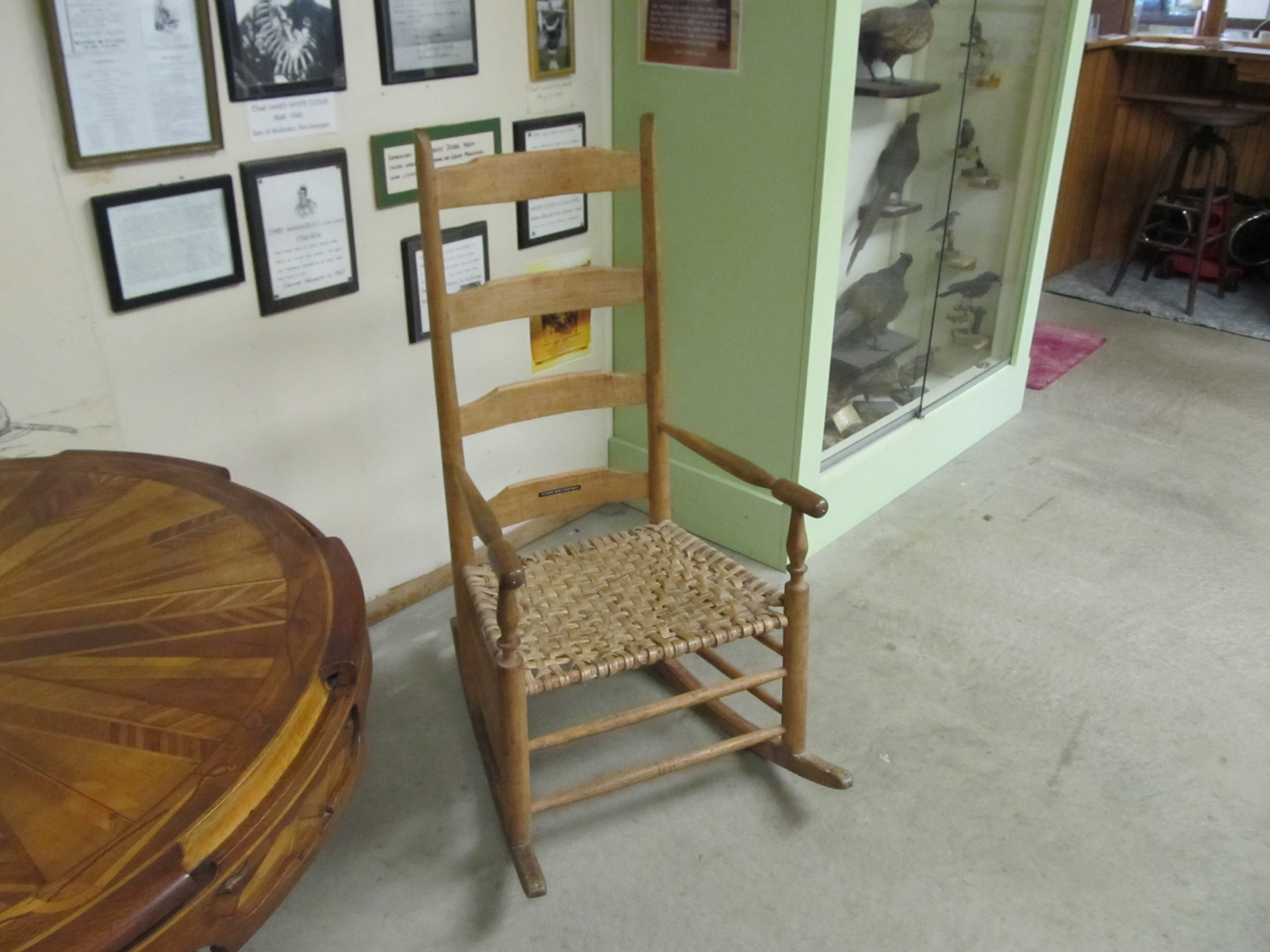Just 100 years ago, in the year 1845, there came to Iowa from Indiana, my father's maternal grandfather, Thomas Lee, and his father, Christopher C. Mattix, both entering land from the government and settling in the northeast part of Jefferson Township, Mahaska County. The Indians were still here at that time, and there were still a few deer roaming the countryside.
My father was born March 27, 1860, in a log cabin not far from the banks of Coal Creek on the old homestead in section 11, Jefferson Township. Here he spent his boyhood days growing up, we might say, with the country. When he was 11 years old, his mother, Harriott (Lee) Mattix, died, leaving a large family. After his mother's death, whose loss he felt keenly throughout all his years, my father was thrown largely upon his own resources, getting what schooling he could from the pioneer schools of that day. It can truthfully be said that my father was a self-made man and as I think of his life today, I think he did remarkably well, for all that he had to come through. As he grew into manhood, he lived with relatives or worked for others at a daily wage, which today would seem very meager indeed.
He had no trouble finding work or making friends. As he was industrious by nature, he was always busy and took pride in doing his work well. He went to Nebraska one summer, making his home with his brother, [Thomas] Jefferson, who lived at Red Cloud. Here he worked at various odd jobs. While there, he went through a cyclone that did much damage to the town and for years afterwards if the wind blew very hard, you would see him outside watching the clouds. He never did like storms after his Nebraska experience.
While still a young man, he went to Indiana to visit relatives, working through one winter, making rails and doing other timber work. When planning to return home, some of his kinfolk said that if he would stay during the summer that in the fall they would have a sale and come to Iowa with him. So he stayed, and in the fall they made a sale and loaded their belongings into wagons and started for Iowa by the overland route. As I remember, my father said they were 27 days on the road. Much of the way the young men of the party walked behind the loaded wagons. And so it was that the Winegardner family came to Iowa and here they have stayed. Mrs. Winegardner was my father's aunt. Before she married Abraham Winegardner, her name was Lydia Anne Mattix.
Later, my father went to Indiana by train to visit relatives there. Then when the automobile came, he went by auto, and then once he made the trip by bus. He said, “I would like to make the trip to Indiana by plane once,” and I believe he would have done so, only his days were cut short.
As a matter of history, I mention here that my father's brother Daniel, (the father of Mrs. Clara Breeden), who was born in 1846, claims the distinction of being the first white male child born in Jefferson Township. On January 9, 1884, A.W. Mattix was married to Miss Mary Louise Flanders of Marion county. She, too, was born in Mahaska County, on Section 34 of Scott Township, and lived there until 1869. In that year, her father moved to land he had bought in Marion County, east of Hamilton on the county line. My mother was the daughter of Joseph Dean and Marietta Bixby Flanders, who came from Vermont in 1853.
My parents were married in Marysville, Iowa, by Reverend Runyon, a retired Methodist minister who was running a grocery store there. They came the same day by bobsled down to the Atemus Flanders home in Mahaska County and the next day my father worked on the farm, which years later he bought for his home.
In 1884, my father and mother lived on what was then known as the L.J. Holcomb Farm in Jefferson Township, located in Section 1 about one-half mile east of Coal Creek Church. The next year, they moved to Grandfather Flander's farm in Marion County. Here they lived until 1892, when they bought and moved to the farm which was to be their home for the rest of their lives. It was then known as the Harvey Shontz Place and is located in Section 6, West Des Moines Township, just east and south of the Eveland Bridge joining the river.
I can well remember the brave struggle my father and mother made to pay for the farm and how hard they worked, and by careful planning and saving, they finally succeeded. But it was no easy matter going through the depression and drought of 1893 and 94, when corn sold from 10 to 15 cents per bushel. It was during this time my father sold nine head of good cattle for only $75. I might mention here that my father was a lifelong friend of John A. Kalbach, for it was he who helped him with his financial problems through those trying years. In the year 1896, the old log cabin was torn down and a better house was built. It is now the home of my brother, W.A. Mattix. In 1904, the old Shontz barn was replaced with a larger and better barn. In fact, every building on the farm was built in the active years of my father's life. During these years he not only farmed the home place but rented other land, doing sharecropping on the old Henry Eveland farm and on the Peter Tharp Farm across the river (known as the Benny Godfrey farm), now occupied by Clifton N. Patrick. We were farming this place in 1903 when the Des Moines River reached its highest flood stage ever known. During that flood, the second span from the south end of Eveland Bridge was carried out by a large cottonwood tree. For the rest of that year, we had the problem of getting across the river to do our farming. I mention here that I heard the crash as the bridge went out and ran to the river in time to see the tree that did the damage before it had gone very far down the river. There were two of the Lockwood family who actually saw the span go out. I mention this too, that I can remember the two large posts set on the south side of the river which held the cable for the last Ferry Boat that was run at that place, operated by Benny Godfrey but known as Eveland Ferry. For many years we got our mail at the country post office known as Ferry, which was kept in the home of some farmer nearby. This continued until the Rural Free Delivery came, then our post office was transferred to Beacon.
It was about this time that we got our rural telephone lines, the auto, and the radio had not come yet.
My father continued to farm until 1912, when he turned the work end over to the younger generation. Retiring from active farm duties yet living on the old homestead, he devoted his time to gardening, paper hanging for his friends, and doing other things he was interested in. I wish to say here that during my father's active life as a farmer, that most of the work was done with walking machinery. The ground was plowed with walking stirring ploughs, cultivated with walking cultivators, and only in the later years did he have for himself a riding cultivator. I have often wondered how many miles we did walk in those years when we had 70 or more acres of corn to tend. I remember one time Phil Hoffman of the Oskaloosa Herald did give us a write up in which he had figured out how far we had walked but I do not recall the figures now.
The winter of 1920 my father and mother spent in Pensacola, FL, where he worked most of the time in the shipyard there. Here he secured many items included in the “Memorial Collection”. My father was of a genial, happy disposition, and made friends readily everywhere he went. From these friends and contacts came many of the things to be found in his collection. He was many years getting together this offering. They came from many states and countries overseas. To him, each item was connected with a friend, an incident, or contact made somewhere, which only he could correctly relate. To him they brought many happy recollections, he prized these relics and souvenirs as he prized his friends.
We did talk sometimes of selling his collection, and no doubt could have done so at a good price, but he said to me one day, “Charlie, I don’t know whether I could sell them or not, it would be just like selling my friends.” And it is my opinion that he never would have done so – they meant so much to him. On many of the Indian arrowheads you will find the name of the one who found it or gave it to him. As far back as I could remember he had been collecting Indian relics, and the pioneer articles have accumulated throughout the years from many sources. I will not attempt to name them here but will let them speak for themselves.
 My father was handy with tools and it seemed that he could do anything he undertook to do. He found great joy in making souvenirs for his friends. Mostly they were made of wood and generally of red cedar, walnut, or hickory. Especially did he enjoy making items for children, and in many homes today you will find some of the handiwork fashioned with his pocket knife or just common hand tools. He made these items evenings and in his spare moments, and this is what he was doing the very last thing before he died. He had for many years kept a Diary. The last entry he made was the evening before his death.
My father was handy with tools and it seemed that he could do anything he undertook to do. He found great joy in making souvenirs for his friends. Mostly they were made of wood and generally of red cedar, walnut, or hickory. Especially did he enjoy making items for children, and in many homes today you will find some of the handiwork fashioned with his pocket knife or just common hand tools. He made these items evenings and in his spare moments, and this is what he was doing the very last thing before he died. He had for many years kept a Diary. The last entry he made was the evening before his death.
My father was a strong man physically and for many years he weighed 200 pounds or more. He did much hard work in the prime of his life. Before cement was used to make concrete, he did much mason work building arch caves of stone, laying foundations for buildings and making chimneys, etc. He was a woodman of no mean ability and did much timber work, making hundreds of fence posts, and, through all the years he cut timber for firewood. He knew what a grubbing hoe was, and he knew how to use it, and did. He also knew how to score a log and to use a broad ax. He also knew how to make an old-fashioned pin sled, hay rack, and shaving horse, and many other things that were used in the early days of our Commonwealth. Some of these articles you will find in miniature in his collection made by his hands.
As I have already said, he took pride in doing his work well. He liked to plow a straight furrow. He could drive the straightest corn row, he could hew to the line and set a line of fence posts in perfect line. I like to think that this was indicative of his character – straight-honest-upright and true.
Of one thing, my father was rather proud, and that was his record as maker of sorghum molasses. For nearly 40 years he worked at it, and won quite a name for himself because of the quality of his product, which found its way into many of the better homes far and near. Some years, the output would run into several 100 gallons, many times he would take prizes at the Farmers Institute and County Fairs.

He was very proficient in putting split hickory bottoms in the old-fashioned chairs. Some of our Historical Society members have some of these in their homes, and some are found in his collection; also the bark as he prepared it to be used.
My father did not aspire to political power or fame, but content to live in a house by the side of the road and be a friend to man.
In his religious life, he was sincere. He was a member of the United Brethren in Christ Church and for a number of years was a member of the Coal Creek Church class and was active in both church and Sunday School. He kept his faith unto the end.
He was a member of the Odd Fellows Lodge for more than 50 years. He was very proud of the Badge of Honor that was presented him upon completion of his fifty year membership which he held at Hamilton (now consolidated with the Bussey Lodge).
There was born to my father and mother five children. One daughter and four sons. The daughter, Nellie Salome, became the wife of W.E. Batey but was deceased in 1904 and is buried in Coal Creek Cemetery. One son, Roy, died in infancy and is buried at Hamilton. The three sons now living are, in order of their age, Charles Dean, Winfred Aaron (on the old home place), and Jesse Clinton of Leighton.
My father and mother celebrated their golden wedding anniversary January 9, 1934, with their three sons, 12 grandchildren, and two great grandchildren, and a large company of relatives and friends. The open house held in the afternoon and evening was a joyous occasion. I think it was one of the happiest days of their lives. After this, we kept each anniversary as it came, they just lacked one month of living together for 56 years.
Mother died December 9, 1939. This left my father lonely and sad, although he tried to be brave and cheerful yet something had been taken out of his life that could not be replaced. He had confided in and depended upon her for so long and she had never failed him at any time. While mother was not strong physically and had not been in good health for many years, yet she possessed all the virtues and principles that make for true character, and she was honored and respected by all who knew her. I have said father was a self-made man, yet much credit must be given my mother for her influence and help. She was the anchor that held him at all times. She was a true helpmate and a worthy mother.
Father lived on at the old home for nearly two years after Mother's death; some of the relatives living with him during this time, but life was different and he was alone much of the time. He missed very keenly the companionship of former years. He seemed to age rapidly and it was evident to all that he was failing in health, yet he kept going and was quite cheerful most of the time. He was not sick, and the day that he died, he walked to my house (nearly half a mile) to eat dinner, visit, and joke as usual. Then he walked home near the middle of the afternoon, and about 5:30 PM, quietly and quickly, the summons came and we were left to mourn.
This happened November 26, 1941, just a few days before Pearl Harbor, and as I write this sketch the word has come that Germany has unconditionally surrendered -- a day of rejoicing to all.
My father was laid to rest in the Coal Creek Cemetery by the side of Mother. In less than half a mile and in sight of his birthplace, and facing eastward in view of the home that had been his for nearly fifty years. So ended his earthly life.
In presenting to the Mahaska County Historical Society his collection, we have done so in his honor. He was a son of Mahaska County, and proud of his birthplace and heritage. We trust that Mahaska may be proud of her son. With this thought in mind, that his memory may live on, we have given this collection as a Memorial to his worthy life and name. And this is the tribute of his son: HE WAS A GOOD MAN. May it be said of him, as of one of old, “He being dead, yet speaketh”. Through this offering we have made of his valued treasures to the Mahaska County Historical Society, we count it an honor and a privilege and trust that it may be an incentive to others to give and help until Mahaska County may have a permanent place and one of the best historical societies in all the State of Iowa.
Respectfully submitted on the 9th day of May 1945.
Charles D. Mattix
Read at the Annual Meeting [of the Mahaska County Historical Society], 1945, by Charles Mattix.
Also read at the 20th Anniversary Meeting, January 31, 1962, by Charles Mattix (tape recording)
This is a copy of the original paper of Reverend Charles D. Mattix.
Signed Mrs. Stillman Clark, Historian (1962)